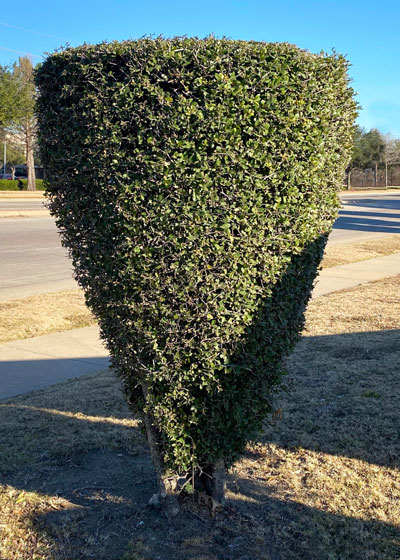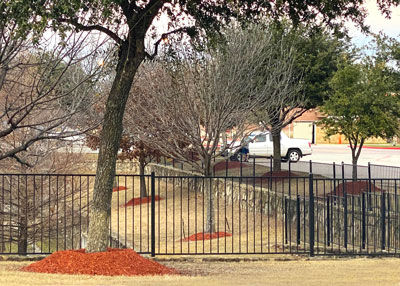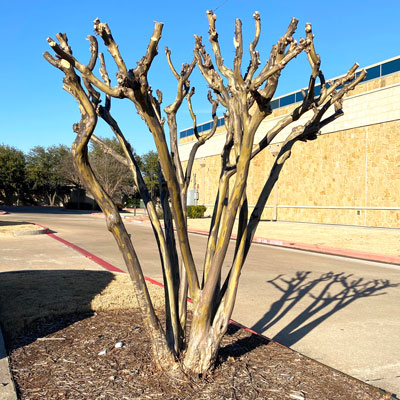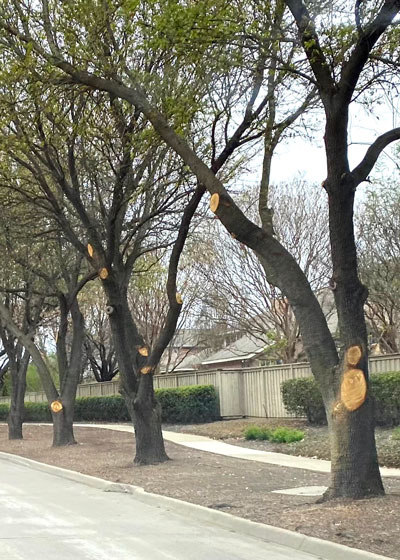Just Because the Pros Do It…
Landscaping is an art form. That means that there can be a lot of personal opinions. I’m going to share some of mine – things I feel were done incorrectly. I’ll tell you why. Others may disagree, but this will give us a beginning for discussion.

V-shaped pruning
I’ve been driving past this poor plant 10 times a week for the past 20 years. That’s maybe 7,000 times that my heart has hurt for it. There’s a lovely shrub hidden inside this bizarre little prison. It’s crying to be let out if someone would just quit pruning it this way. But they keep doing it because the crew last year and the crew the year before that couldn’t break the bad habit.
The worst thing about pruning a shrub to a taper like this is that it prevents sunlight from reaching those leaves at the bottom. Someday the plant is going to thin out and become lanky. That crew that year will decide it’s too ugly, and they’ll just yank it out. But it’s not too late yet. Maybe some crew before then will let it grow out. We can hope.

Mulch volcanos
When trees are planted into new commercial landscapes, some crews will just pull the extra soil up around their trunks and hide it with mulch. It’s a lot easier than hauling it off. Then they come back year after year and top-dress the hills with piles of fresh mulch.
The mulch is supposed to keep water from evaporating out of the soil surface, but the reality is that the mulch actually prevents water from getting into the root zone in the first place.
“Planting high” like that also places the root flare inches above grade, so surface roots become visible much sooner than necessary. People don’t like those roots because they trip on them and because they break pavement.
I’m out on this one.

Why do we do this?
There is never any reason ever to “top” any crape myrtle. Yet crews are sent in to perform this butchery.
Examine these facts:
• Topping does not make crape myrtles bloom better. It actually slows down the date of first bloom by 6 or 7 weeks. That means you’ll have one or two fewer rounds of flower production each year.
• Topping does not keep them from growing too tall. (Height is genetically pre-determined – cutting them back only gives temporary relief.)
But…
• Topping does ruin their natural form and leave you with a massacred mess.
The only way to salvage a plant like this would be to cut it completely to the ground, then train the new, vigorous shoots to into straight trunks. It does work!

Live oaks pruned incorrectly several times over
I took this photo April 4, 2021. All of these trees survived the great freeze of February, but then the decision was made that their branches were encumbering truck traffic along this major roadway.

• Live oaks are not “street trees.” They eventually spread to 50 to 70 feet wide and their lowest branches often hang down to the ground. That’s their genetics, and pruning won’t change it. Plus, they develop large surface roots that will end up breaking curbs and sidewalks.
• Too much top growth was removed at one time. This put the trees into shock. Hopefully they will recover. Time will eventually tell.
• These gaping wounds left none of the branch collars in place. It will take years longer for these trees to heal, if indeed they are able to heal completely.
• This pruning was done at the worst possible time. According to the Texas Oak Wilt Partnership (https://texasoakwilt.org), the oak wilt fungus is most active in spring. They tell us that oaks should not be pruned between February and June (inclusive).
• The Oak Wilt Partnership also tells us that all cuts larger than our pinkie fingers must be protected with pruning sealant or some type of paint. Nothing was applied to these massive cut surfaces.
Someone was paid a great deal to do a mile of this pruning. Let’s just hope that the public didn’t pay any attention to when and how it was done.
